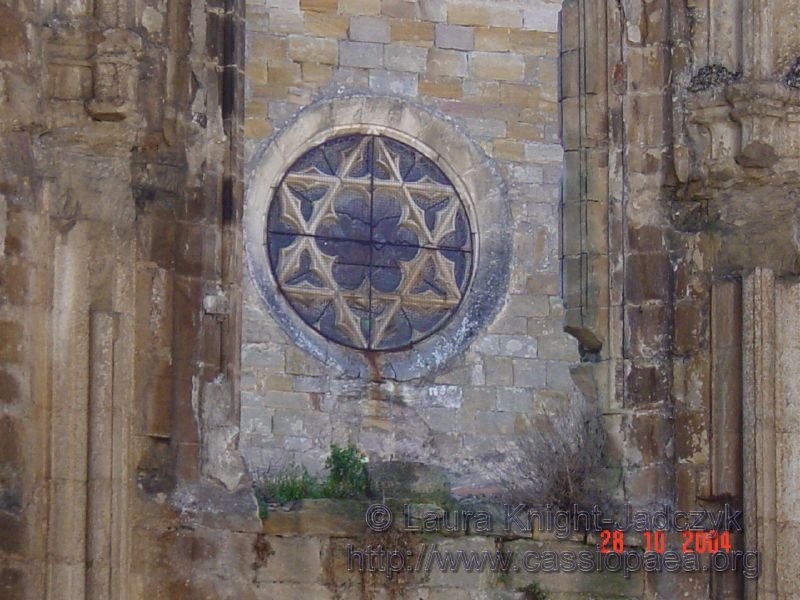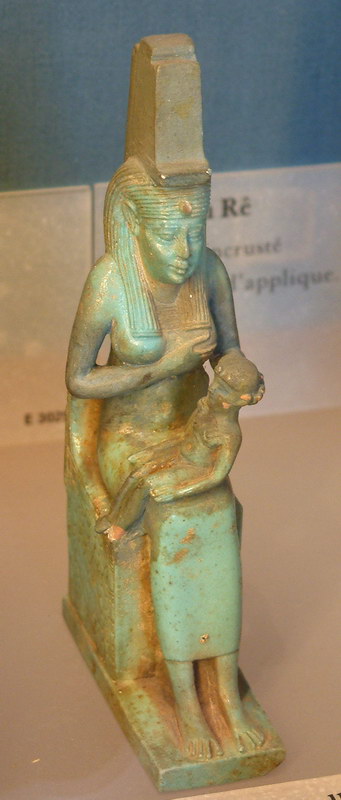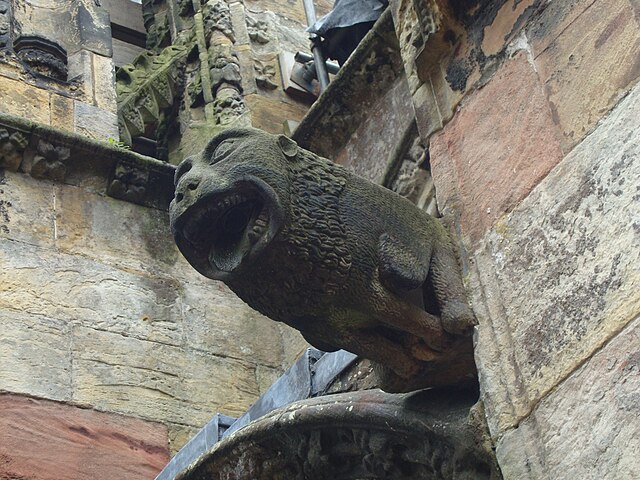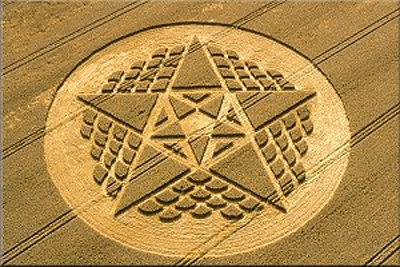|
|
General: ¿CUAL ES EL MISTERIO QUE ESCONDE RENNES LE CHATEAU?
Elegir otro panel de mensajes |
|
|
Rennes-le-Chteau: El Misterio De La Tumba
|
|
 n oscuro monumento situado en las cercanías de Rennes-le-Chteau sirvió de modelo para un cuadro pintado en Italia y expuesto actualmente en el Louvre. Éste y otros enigmas vinculan al abate Saunière con historias de tesoros ocultos y órdenes militares. n oscuro monumento situado en las cercanías de Rennes-le-Chteau sirvió de modelo para un cuadro pintado en Italia y expuesto actualmente en el Louvre. Éste y otros enigmas vinculan al abate Saunière con historias de tesoros ocultos y órdenes militares.
|
| |
|
 |
 |
|
El arco de triunfo de Tito, en el foro de Roma, muestra la gran menorah (candelabro de seis brazos), las trompetas de plata y lo que podría ser el Arca de la Alianza, todo ello tesoros del templo de Salomón.
|
Cuando Béranger Saunière pasó varias noches en el cementerio de Rennes-le-Cháteau borrando las inscripciones de las dos lápidas de la tumba de Marie de Negri d'Albes, no sabía que ya habían sido copiadas: una vez por el Bulletin de la Société des études scientifiques de l'Aude, y otra en un libro de Eugène Stublein, Pierres gravées du Languedoc.
La primera lápida se ha perdido. En la transcripción, llaman la atención los errores que contiene. Al parecer, fue encargada por el que era entonces abate de Rennes-le-Cháteau, Antoine Bigou.
La segunda piedra subsiste, sin ninguna inscripción, como tapa de un osario, en el rincón noroeste del cementerio. Tenía grabadas una serie de frases enigmáticas, entre ellas un lema monogramático que también aparece en uno de los manuscritos que descubrió Saunière. Una de las frases es el conocido dicho latino Et in Arcadia Ego, cuya traducción es «Yo también estoy en Arcadia». Significa que aun en el legendario paraíso de los pastores griegos, la muerte estaba presente.
Saunière trajo consigo de París una reproducción del cuadro «Los pastores de Arcadia» de Nicolás Poussin, pintado entre 1635 y 1650. Representa a tres pastores y una pastora clásicos ante una gran tumba, en la que se lee una inscripción: «Et in Arcadia Ego». Y a 10 kilómetros de Rennes-le-Cháteau, en una colina rocosa, está esa misma tumba. Ha sido recubierta con cemento, de modo que no se aprecia ninguna inscripción, pero su forma es inconfundible y hasta ciertos picos montañosos del horizonte pueden ser identificados.
Marie de Negri estaba emparentada con la familia de Hautpoul, descendiente de Bertrand de Blanchefort (primer Gran Maestre templario), y con los Fleury, que recibieron la herencia familiar. En 1644, François-Pierre de Hautpoul, barón de Rennes, hizo testamento y le agregó documentos que apoyaban el derecho al título de la familia durante más de 600 años. El testamento y los documentos se extraviaron durante más de 130 años. Cuando fueron recuperados en el despacho de un notario y un Hautpoul quiso verlos, recibió la siguiente respuesta: «No sería prudente por mi parte hacer público un testamento tan importante...» Los papeles volvieron a desvanecerse.
En 1792, Bigou rehusó jurar fidelidad a la nueva República Francesa y cruzó la frontera en dirección a España, donde murió. La familia Fleury también se exilió.
 |
|
Al parecer, éste es el modelo de la tumba que pintó Poussin en su cuadro, aunque un recubrimiento de cemento impide apreciar si en ella ha habido inscripciones. Este enigmático monumento se halla en una colina cercana a Rennes-le-Chteau, en la parroquia de Arques.
|
Pero en la decoración de la iglesia, Saunière hizo una alusión directa a las tierras de los Fleury. Sobre el confesionario hay un gran relieve que representa a Cristo en el monte de los Olivos, hecho de madera y yeso. El empinado montecillo está lleno de flores (fleuri, en francés) y el paisaje del fondo tiene rasgos del de los alrededores de Rennes.
Se ha especulado con el significado del texto que hay debajo de este cuadro: «Venid a mí, los que estáis abrumados, y yo os daré el descanso». En francés, «los que estáis abrumados» se dice «vous qui êtes accablés», y es fácil descubrir las palabras été (verano), sac à cable (saco con cuerda) y blé (trigo, pero también tesoro, en lenguaje coloquial).
Se han descubierto acertijos del mismo tipo en la inscripción de una imagen de la Magdalena que el mismo Saunière pintó en el panel delantero del altar. El ingenuo relieve muestra a María Magdalena arrodillada en una gruta. Existen muchas grutas y cuevas alrededor de Rennes. En su juventud, Saunière debió de conocer a un viejo ermitaño que vivía no muy lejos, en la garganta de Galamus, en una gruta o aven aislada y dedicada a San Antonio, parecidísima a aquella en que se arrodilla la Magdalena, y que también coincide con la descripción del abismo en el cual el pastor Paris descubrió sus monedas.
Por otra parte, existe un vínculo significativo entre San Antonio y María Magdalena. San Antonio está considerado como la primera persona que organizó la vida monástica. Algunas de sus reliquias fueron trasladadas a Francia, y en el siglo XI se construyó una gran catedral para custodiarlas. Quienes habían recuperado las reliquias fundaron la Orden de San Antonio, que finalmente se fusionó con una de las grandes órdenes militares, los Hospitalarios de San Juan.
 |
|
Losa de la tumba de Marie de Negri d'Albes, con el lema «Et in Arcadia Ego» grabado en caracteres latinos y griegos.
|
Se dice que los antoninos introdujeron el culto de Santa María Egipcíaca. Ésta, que vivió a fines del siglo IV, había sido prostituta en Alejandría. Pero inspirándose en la historia de San Antonio se arrepintió, y pasó el resto de su vida sola en un lugar desierto. Se la confundió con María Magdalena en la oscura leyenda de las tres Marías, evangelizadoras de la Provenza, con lo cual enlaza también con los cultos de las vírgenes negras que había sobrevivido en toda Francia en grutas subterráneas, dedicadas a la antigua diosa madre.
Por otra parte, después de la ascensión de la masonería en Francia, no pasó mucho tiempo antes de que se afirmara que existía una conexión legendaria entre los antiguos secretos de los constructores del templo de Salomón, los caballeros templarios y la masonería escocesa.
Cuando Béranger Saunière llegó a París en enero de 1893, se encontró en medio de una disputa entre la Ordre Kabbalistique en la Rose-Croix y la Ordre de la Rose-Croix Catholique du Temple et du Graal. El Rosacrucianismo y la Rose-Croix no eran nuevos en Francia. Ya en 1623 se dijo que el filósofo Descartes era rosacruz. Y en la Francmasonería, el grado 18 del rito «escocés» es el Caballero del Pelícano y del Águila y Príncipe Soberano Rosacruz de Heredom.
Pero la Francmasonería fue prohibida en tiempos de la Revolución Francesa. Aunque Napoleón revivió el interés por el movimiento, hubo que esperar a la restauración de la monarquía para que volviera a florecer, combinado con un creciente interés por el ocultismo.
El hilo está enredado, y hay pocas o ninguna prueba de que las extravagantes afirmaciones que se han hecho sean ciertas. Pero si los templarios o los antoninos hubiesen poseído información secreta, ésta podría haber pasado a los hospitalarios, que se hicieron cargo de gran parte de las propiedades de los templarios, o podría haber pasado de generación en generación a través de las familias supervivientes. Quizá sea cierto que los Rosacruces poseían un secreto, como pretendían ellos; quizá la Francmasonería tiene realmente la clave del enigma Rosacruz; quizá algún ocultista de París reconoció en los papeles que traía Saunière la clave de algo perdido y muy preciado.
 |
|
Lápida de la tumba de Marie deNegri d'Albes. En ella hay un considerable número de errores.
|
Junto a la entrada de la iglesia de Rennes puede verse una figura de Asmodeo, «demonio y guardián» que custodiaba el tesoro de Salomón. Encima de él hay cuatro ángeles. A primera vista, éstos parecen hacer la señal de la cruz, pero el ángel de arriba tiene la mano izquierda en el pecho y la mano derecha encima de la cabeza: éste es el gesto de Asmodeo, el signo que rodeaba la cabeza de macho cabrío de Baphomet en los ritos de los templarios.
Y así están las cosas, por el momento. Todavía no sabemos -y probablemente no sabremos nunca- qué fue lo que encontró Saunière. El misterio empieza con el descubrimiento de los manuscritos y su conexión con la tumba de Marie de Negri d'Albes. Sólo dos de los cuatro manuscritos han sido fotografiados y publicados; quizá fueran los menos importantes, y los otros proporcionen detalles más explícitos acerca de la ubicación del tesoro, cuya leyenda había ido pasando, de generación en generación, por la familia Blanchefort.
Pero la pieza que faltaba tenía que ser, o un documento, o el mismo tesoro y, presumiblemente, la tumba que pintó Poussin contenía alguna clave, razón por la cual fue cubierta de cemento. También la gruta puede haber contenido un tesoro escondido -de los visigodos, de los cátaros, de los templarios- cuya recuperación puede haber sido confiada a Saunière con la debida supervisión. Quizá éste, como muestra de agradecimiento, restauró su iglesia con motivos que hacían una enigmática referencia al origen de su riqueza.
El papel desempeñado por el Prieuré de Sion, la conexión con los Habsburgo y todas las ramificaciones de esta organización casi desconocida... son otra historia.
El Secreto De La Tumba
 |
|
Hay dos versiones del cuadro de Poussin, donde en una ha desaparecido el cráneo y algunos personajes han sido sustituidos por otros.
|
El cuadro de Poussin «Los pastores de Arcadia» del que existen dos versiones, plantea algunos problemas fascinantes. La primera versión, que pertenece en la actualidad a la colección de Chatsworth House, en Derbyshire (Inglaterra), se inspiró en un cuadro del Guercino, ejecutado en 1620, y parece probable que el Guercino o sus mecenas, Giulio Rospigliosi, que después fue el papa Clemente IX, compusieran la famosa frase «Et in Arcadia Ego».
En el cuadro del Guercino, dos pastores han encontrado un cráneo humano apoyado en un bloque de piedra en el que está grabada la inscripción; en la primera versión de Poussin, dos pastores y una pastora leen la inscripción en una tumba ornamentada al estilo clásico. El cráneo, que forma parte de la decoración de la tumba, es apenas visible, y la cuarta figura es una personificación del río Alfeo.
La segunda versión del cuadro, la que se halla ahora en el Louvre, es visiblemente distinta. El cráneo ha desaparecido, Alfeo ha sido sustituido por un tercer pastor, y las posiciones de las figuras han cambiado. En cuanto a la tumba, ha perdido toda su elegancia y su decoración; ahora constituye un bloque casi cúbico de piedras toscamente talladas, y la parte superior tiene la característica inclinación de la tumba solitaria de las afueras de Arques. Parece imposible que Poussin eligiera como modelo semejante monumento a menos que el original le resultara familiar. Y, ¿qué razones pudo tener para realizar una segunda versión de un tema no muy corriente? En efecto, este tema parece haber tenido un significado especial en la vida de Poussin: cuando su tumba, en Roma, fue restaurada por Chateaubriand en 1829, le agregó un relieve con los pastores de Arcadia.
http://www.mundoparanormal.com/docs/enigmas/rennes_le_chateau_el_misterio_tumba.html
|
|
|
|
|
|
Rennes-le-Chateau. Blanchefort. Bezu. Serre de Lauzet. La Soulane. Five mountains, equal distances apart, they form the shape of a pentagram.  This pentacle points at the North Pole. As it existed 10000 years ago.  Precession |
|
|
|
|
 in the corners are the trefoils in Saunieres study I love this picture of the Meandros and the cubes at Rennes http://www.rennes-le-chateau-rhedae.com/rlc/chl/dallage.jpgthere is magic inside the church at Rennes  Merovingian shield 
_________________
Everything is Connected and there are no
coincidences
|
|
|
|
|
I love your pictures of the Dolmen there and the Romanesque Pillars and the star on the outside
It has a sacred well
All the ingredients of worship of the goddess .....Notre Dame ....Our Lady
the 13th century chapel looks like it is built over a pagan site
but Nic I want you to observe the wall paper in side ....has that brick like pattern
very much like Rennes Chapel
the wall paper behind Magdalene it has little squares on the edge of random brick pattern and a design kinda like a cross ....but the chapel at Centeilles has the random brick pattern and a star lots of stars ...like Sauniere's Magdalene chapel The sacred image of Isis with the Horus Child in Rome often became a model for the Christian Madonna with the Child Jesus and many of the epithets of the Egyptian Mother of God came to be used for the Christian Mother of God  A picture of a Black Isis ...or Black Madonna 
_________________
Everything is Connected and there are no
coincidences
|
|
|
|
|
the gargoyles of Rennes http://www.flickr.com/photos/mrachab/5057315154/Gargoyles are said to frighten off and protect those that it guards, such as a church, from any evil or harmful spirits. A French legend that sprang up around the name of St. Romanus ("Romain") (AD 631–641), the former chancellor of the Merovingian king Clotaire II who was made bishop of Rouen, relates how he delivered the country around Rouen from a monster called Gargouille or Goji. La Gargouille is said to have been the typical dragon with batlike wings, a long neck, and the ability to breathe fire from its mouth. There are multiple versions of the story, either that St. Romanus subdued the creature with a crucifix, or he captured the creature with the help of the only volunteer, a condemned man. In each, the monster is led back to Rouen and burned, but its head and neck would not burn due to being tempered by its own fire breath. The head was then mounted on the walls of the newly built church to scare off evil spirits, and used for protection.[4] In commemoration of St. Romain, the Archbishops of Rouen were granted the right to set a prisoner free on the day that the reliquary of the saint was carried in procession (see details at Rouen). The ancient Egyptians, Greeks, Etruscans and Romans all used animal-shaped waterspouts  Themes of gargoyles disembodied heads....like the Celtic head hunters Giants....devouring open mouth giants Green man Sex objects The pagan symbolism runs through like Rosslyn Chapel's green man The mouth pulled open is a frequent symbol of devouring giants.....the Giants a recurring theme in the Bible and throughout many cultures http://www.cwrl.utexas.edu/~bump/oxford/gargoyles.html
_________________
Everything is Connected and there are no
coincidences
|
|
|
|
|
For the first time I spotted the Solomon Seal of the Star of David at Rennes ....I saw the pentacle but not the hexagon and thanks to Nic going to Rennes on his vacation I found it... Its on the wall paper surrounding the Crista ....its a intertwining of two hexagons or Jewish stars I've seen this symbolism where the Acadians lived
BULLDOGNIC wrote:
I started a new topic for this as the last one unfortunately doesn't contain it's images now. I feel it's important to bring to everyone's attention the degradation of the structure and painting inside the RLC church. As has been mentioned before, the tiles are extremely cracked on the floor mainly in front of the altar and beneath the pulpit. Here are examples :-   Now one thing that I found slightly disturbing was that the window to Sauniere's " secret room " has been removed, leaving it open to the elements ( and possibly entry by someone small enough ? ). I took a photo of the interior again. This time I noticed that the wall connected to the church seems to have been re-plastered or cemented since the last time I was there. Also in the photo you can see on the wall next to the door is a gap to the floor ( with a black pipe coming out ! ), I hope no-one has been doing "work" that leads under the floor in front of the altar. See for yourselves :-  Not only is the floor starting to subside but the infamous "Crista" motif now has huge cracks across the wall, and on the opposite side of the church the Fleury Tableau also has signs of cracking starting to appear. :-   This damage was not present a year ago as my previous photos can substantiate. I find this extremely worrying with questions needing to be answered as to IF someone has tried to gain access to the supposed "Tomb of the Lords" next to the pulpit and opposite the "secret room". Also, if money is coming into the museum/Sauniere's domain, surely some of this should be used to help the upkeep of the church rather than new exhibitions in the Tour Magdala or re-styling the gardens. I am aware that the responsibility for the church is not the same as Sauniere's domain because they are independently owned, however which do you you guys think deserves immediate funding ? On a different note, a couple of things I spotted. Firstly on the Fleury Tableau it looks like the "Venez A Moi" has been re-written, as to the left of the word "Venez" you can see it again very faintly. I think this has been mentioned before but here's the photo anyway :-  I also managed to get a snap of the text on the St Luke statue of the writing on his book. It just looks like random scribbles to me, but who knows?  Ben Hammott also covers this here:- http://www.benhammott.com/saint-luke-book-text.htmlFinally, a while back we had a discussion regarding the stonework images on the front porch so I took the opportunity to get as clear a photo as possible ( just in case it's not there next year  ).  To be honest, I was appalled at the general state of the church, and came away quite upset and slightly angry that so much damage could have occurred in such a short space of time. I hope that either the local Marie, the RC church or some outside group can help the situation before it gets any worse. Regards Nic
_________________
Everything is Connected and there are no
coincidences
|
|
|
|
|
 in the corners are the trefoils in Saunieres study I love this picture of the Meandros and the cubes at Rennes http://www.rennes-le-chateau-rhedae.com/rlc/chl/dallage.jpgthere is magic inside the church at Rennes  Merovingian shield 
_________________
Everything is Connected and there are no
coincidences
|
|
|
|
|
I remember a scetch, painted by Plantard or de Sede, where a tower was painted on that place. And I remember an old photo, taken from the eastside of RlC, where ruins of thick walls are visible on that place.  .  hope it can help you. regards Hans
_________________
Yes, I am living in a world of shit, but I am alive...
|
|
|
|
|
here is another crop circle discovered next to the Silbury Hill (Wiltshire) in England in 2002.  The 13 "scales" or "fans" or "sweeps" (orbits, i.e., years) between points are interesting because, according to our calculations, the Venus-Earth pentagram rotates in the solar plane and overlaps the next point in 12¾ earth years. There is a macro vs. micro view in the crop circle as well. In the macro we get orbits and in the micro (inner 5-point star) we get the two kinds of the golden triangles for the orbitals (72, 72, 36 and 36, 36, 108 degrees). Article about Poussin's pentacle using the golden triangles degrees http://andrewgough.co.uk/mrrigby.htmlOrbit ratios. Mayan astronomers first observed, measured, and applied the periodic relationship between the planet Venus and Earth. It turns out these two bodies have interlocked orbits in a ratio and that means that the planetary orbits of Venus and Earth are not independent of each other. The ratio is very close to 8:5 -- for every eight Venus orbits (cycles), our Earth completes five orbits (years). While this is not a source of orbit problems, the orbit's fixed ratio (interlock) allows Venus and Earth to become effectively a single planet in one orbit. The resulting merged planet is moving close to the midpoint between Venus and Earth because both of these planets are of about the same size (have about the same mass). From the Sun's point of view the positions of both Venus and Earth periodically occupy the same two spots on the solar plane and the merged planet is then also in a spot it occupied before. Every time Venus catches up with Earth the merged planet reaches its aphelion, the farthest distance from the center of the Sun. For such merged planet the time between aphelions happens every 1.6 earth years. The interlock of the two orbits merges both planets yielding one highly elliptical orbit that rotates and repeats every eight years -- that is, the merged planet passes the same starting point every eight years while its path is curved. During these eight years the merged planet reaches aphelion five times, tracing a star with five points and taking 1.6 years between points. http://www.hyperflight.com/venus-five-pointed-star.htmSome of Rennes Chateau pentagrams on the tablecloth of the stained glass window over the altar the stars on the roof of the church the landscape of the area the chapel with the glass roof with stars above it at Rennes Poussins Shepherds of Arcadia The whole chapel has roses which is Venus Mary's and Isis favorite flower...which is connected to the pentacle
_________________
Everything is Connected and there are no
coincidences
|
|
|
|
|
 in the corners are the trefoils in Saunieres study I love this picture of the Meandros and the cubes at Rennes http://www.rennes-le-chateau-rhedae.com/rlc/chl/dallage.jpgthere is magic inside the church at Rennes  Merovingian shield 
_________________
Everything is Connected and there are no
coincidences
|
|
|
 Primer Primer
 Anterior
27 a 41 de 71
Siguiente Anterior
27 a 41 de 71
Siguiente Último
Último
|
|
| |
|
|
©2024 - Gabitos - Todos los derechos reservados | |
|
|

